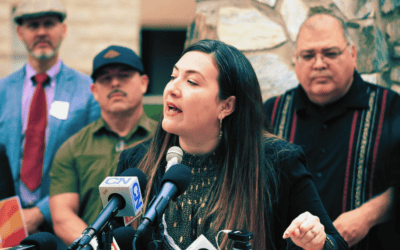
Wildfire air attack helicopters continue to battle the Bighorn Fire along the western side of the Santa Catalina Mountains, Friday, June 12, 2020, in Oro Valley, Ariz. Hundreds of homes on the outskirts of Tucson remain under an evacuation notice as firefighters work to keep the wildfire from moving downhill from canyons and ridges in the Coronado National Forest. (AP Photo/Matt York)
Arizona could take in more up-to-date information on wildfire emissions if it produced its own inventories.
Arizona is one of the worst states in the country for wildfires.
However, some states have put more effort into tracking emissions, an element of measuring of air quality that can impact people’s health.
For example, the California Air Resources Board (CARB) tracks wildfire emissions from year to year.
Arizona, which relies on the Environmental Protection Agency’s National Emissions Inventory (NEI) to produce its emission inventories, only gets that information every three years.
“The NEI uses roughly similar methods to those used by CARB, but on a national scale,” Sean Raffuse, software and analysis group manager of the Air Quality Research Center at the University of California, Davis, told The Copper Courier. “So, similar information is available for Arizona, but not at the same speed and not for every year.”
RELATED: 2020 Is a Record-Breaking Year for Arizona Wildfires. Here’s What We Know So Far.
But the Arizona Department of Environmental Quality argues it provides for air quality monitoring support “above and beyond mandated requirements.”
Spokeswoman Caroline Oppleman noted that temporary air quality data is available through portable monitors, but there is “no data to provide related to historical portable air quality monitors related to wildfire support.” This means that while realtime data is available on the agency’s website, there isn’t a way to view previous measurements.
Wildfire smoke isn’t just bad for the environment – it also carries fine particles that enter people’s bodies and cause health problems, including eye and respiratory irritation, reduced lung function, bronchitis, a worsening of asthma, and premature death.
A recent study from the Journal of the American Heart Association found that cardiac arrest was up to 70% more likely in the San Francisco area on days when there was heavy wildfire smoke.
Raffuse said wildfire emissions data on a historical level is helpful for future planning to mitigate these and other issues.
“Emission inventories such as these are important because they are used as inputs for air quality and risk modeling, assessing regulatory impact, planning locations of air monitors, making policy decisions, and more,” he said.
Amy MacPherson, spokeswoman for CARB, said her state can conduct yearly reports because data is available annually through the California Department of Forestry and Fire Protection.
“Having this information is important to help government agencies and stakeholders understand wildfire load on the land each year,” she said.
MacPherson explained that while monitoring emissions can’t necessarily predict air quality, since that also relies on factors like weather, it can help to fight future fires.
“When an agency or other group is in the planning process,” McPherson said, “this kind of data could aid in prioritizing projects where the fuel load on the land is consistent with land where past fires released high levels of emissions.”
Improvements, But Unknowns
Oppleman said that even as Arizona’s economy and population have grown over the past few decades, “the quality of the air we breathe is better overall.”
According to ADEQ, the state has reduced emissions by more than 60% over the last 30 years.
However, it’s difficult to know where wildfires stand in this assessment.
A chart provided by ADEQ shows “criteria air pollutant emissions” decreasing from 1990 to 2018, but it notes that “wildfires and prescribed burns are excluded.”

Air quality as a whole varies widely across the state. In 2019, Tucson had 61.6% days of the year qualify as “good air quality days.” Phoenix only had 13.7%.
But ADEQ is introducing new solutions for evaluating and informing residents about air quality in relation to wildfires.
The agency announced its new wildfire smoke forecast this summer, in which meteorologists will coordinate with fire officials to let communities know how long smoke is expected to last, what activities should be limited, who could be most at-risk for adverse effects, and how to get in touch with fire managers.
A Difficult Fire Season
So far, 2020 has proven to be a difficult fire season for Arizona.
The Bush Fire ate up 186,000 acres northeast of Phoenix and became the state’s fifth-largest wildfire ever. The Bighorn Fire in southern Arizona also caused evacuations and surpassed 100,000 acres burned.
Daniel Glattfelder, senior firefighter with the Globe Interagency Hotshot Crew, said this year has been a lot drier than the last.
While Arizona did see a blaze big enough to crack its top five last year with the Woodbury Fire, Glattfelder said the fires were less frequent.
“[Last year] most of the resource orders that we were sent out on were prepositioning in certain areas that they expected fire, and it never really happened,” he told The Copper Courier. “This year is significantly more busy … than last year was.”
As temperatures continue to rise and environments grow drier, wildfire activity is only expected to increase.
According to the Center for Climate and Energy Solutions, climate change has doubled the number of “large” wildfires in the western U.S. from 1984 to 2015.
Four of Arizona’s six largest fires ever have occurred since 2011.
Why is Air Quality Important?
Wildfires and their resulting smoke can have a significant impact on people’s health.
According to the EPA, “Wildfires increase air pollution in surrounding areas and can affect regional air quality.”
Wildfire smoke alone can cause eye and respiratory irritation, reduced lung function, bronchitis, a worsening of asthma, and premature death.
Although the New England Journal of Medicine has said current pollution measures aren’t enough to protect public health, the EPA recently chose not to strengthen standards for fine particulate matter, which is present in smoke from wildfires.
RELATED: Phoenix Air Quality Has Improved With Stay-at-Home Order. But How Do We Maintain It?
Air pollution as a whole is responsible for more than 5 million premature deaths each year, according to the Environmental Defense Fund.
Children, the elderly, people with underlying medical conditions, people of color, and low-income communities are all at elevated risk for health problems caused by bad air quality.
Support Our Cause
Thank you for taking the time to read our work. Before you go, we hope you'll consider supporting our values-driven journalism, which has always strived to make clear what's really at stake for Arizonans and our future.
Since day one, our goal here at The Copper Courier has always been to empower people across the state with fact-based news and information. We believe that when people are armed with knowledge about what's happening in their local, state, and federal governments—including who is working on their behalf and who is actively trying to block efforts aimed at improving the daily lives of Arizona families—they will be inspired to become civically engaged.


He said what? 10 things to know about RFK Jr.
The Kennedy family has long been considered “Democratic royalty.” But Robert F. Kennedy, Jr.—son of Robert F. Kennedy, who was assassinated while...

Here’s everything you need to know about this month’s Mercury retrograde
Does everything in your life feel a little more chaotic than usual? Or do you feel like misunderstandings are cropping up more frequently than they...

Arizona expects to be back at the center of election attacks. Its officials are going on offense
Republican Richer and Democrat Fontes are taking more aggressive steps than ever to rebuild trust with voters, knock down disinformation, and...

George Santos’ former treasurer running attack ads in Arizona with Dem-sounding PAC name
An unregistered, Republican-run political action committee from Texas with a deceptively Democratic name and ties to disgraced US Rep. George Santos...





